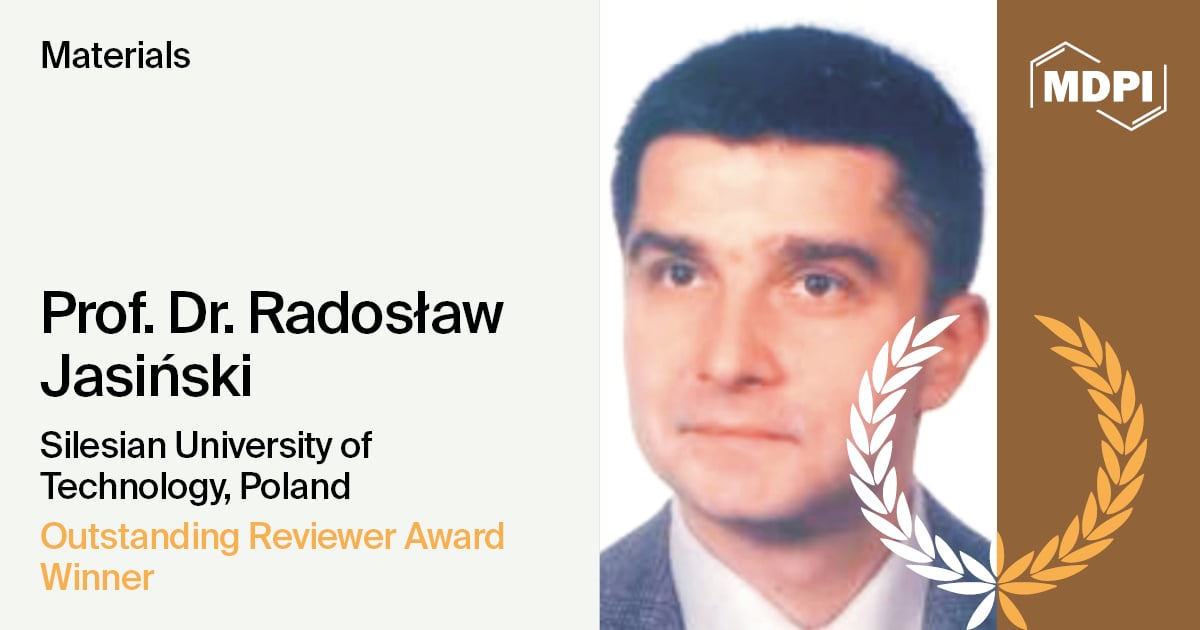
Interview with Prof. Dr. Radosław Jasiński—Winner of the Materials 2024 Outstanding Reviewer Award
The Outstanding Reviewer Award is presented annually to recognize individuals who generously dedicate their time to reviewing papers while demonstrating thoroughness, professionalism, and timeliness.
We are thrilled to share the following interview with one of the winners of the Materials 2024 Outstanding Reviewer Award, Prof. Dr. Radosław Jasiński. In the field of academic publishing, reviewers play a pivotal role as the “gatekeepers” of scholarly quality. Through their expertise and rigorous approach, they meticulously examine each submitted academic paper, ensuring that it meets the highest standards of research and academic quality.
Below is a short interview with Prof. Dr. Radosław Jasiński:
1. Could you introduce yourself to our readers? What is your current research area?
I am a researcher (Full Professor) at the Faculty of Civil Engineering of the Silesian University of Technology, Head of the Laboratory of Civil Engineering Faculty. I am a graduate of the Faculty of Civil Engineering, Silesian University of Technology in Gliwice, specializing in bridges. My scientific interests include masonry structures, reinforced concrete structures, diagnosis of structures (NDT, MDT), and numerical modeling of structures. I publish in journals of various publishers (MDPI, Elsevier, Polish Academy of Science). I have published over 350 publications, handbooks (17), patents (2), papers in technical journals, and at national and international conferences. At the same time, I have reviewed work in the fields of civil engineering and materials engineering in various journals (MDPI, Elsevier, Hindavi, ASCEE) for almost 50 journals (>400 reviews since 2018). In line with my area of interest, I am currently conducting experimental and theoretical research on masonry stiffening walls, with particular emphasis on the redistribution of internal forces. I am analyzing the cooperation of stiffening walls through connections of walls of different structures. I am also conducting research on the broadly understood safety of lintels made of AAC in terms of deflections and support on the wall. Recently, I have also dealt with the issue of fiber concrete resistant to dynamic impacts with kevlar fibers.
2. What factors motivate you to be a reviewer for Materials?
The Materials journal has a recognized reputation among scientists, not only in Poland. Reviewing papers greatly broadens the horizon in terms of research areas and current trends. The best papers published in Materials can, in addition to purely scientific knowledge, also benefit from the workshops of other scientists from renowned scientific centers in the world.
3. What are your tips for preparing a high-quality review report?
Of course, when reviewing each paper, I am guided by the main achievements of the paper and the contribution to the development of a specific discipline: civil engineering, and materials engineering. I try to follow the publisher’s guidelines regarding the principles of conducting reviews, but in addition, I pay attention to the way the publication is prepared. I pay attention to the details in the research program, the description of the research, and the analysis. Wherever possible I provide instructions to the authors. I do not leave my comments without comment. Rather, I try to help the authors improve the manuscript so that it meets all the conditions of scientific work.
4. Based on your rich reviewing experience, could you please share the common problems that authors face?
As I mentioned earlier, most often the authors focus their attention on the research and analyses performed. Often, after analyzing the state of knowledge, the aim and scope of the work, the contribution of the research to the development of the discipline, and the most important achievements are lost. The part describing the research often contains a fairly detailed description instead of more readable tables or block diagrams. When researching structures, static diagrams of research stands and procedures for loading the structure are often ignored. The sections devoted to FEM modeling are not complete. The authors omit descriptions of material models, initial-boundary conditions, and load sequences in nonlinear models. They focus their attention on the results in the form of maps or graphs. I think that the authors should focus their attention on better formulation of conclusions in the summaries of the publication. The summaries are often too laconic and do not present the entire content of the publication and the directions of further work.
5. Materials is an open access journal. Is the peer review process of Materials different from that of subscription journals?
In this respect, the Materials journal does not differ significantly from other journals of renowned publishers. The time allocated for a review is much shorter than in other publishers, but I consider this to be very positive. A significant disadvantage that I would like to draw attention to is the shortening of the review time. Such situations occur when the editor already has two reviews and occasionally the invitation to perform the review is withdrawn. This may discourage potential reviewers.
6. Which research topics do you think will be of particular interest to the research community in the coming years?
I think I will not be original, but potentially the most interesting topics will concern the use of artificial intelligence and broadly understood decarbonization in the production of binders (geopolymers) and aggregates (recycled aggregates) and the use of materials for reuse. It cannot be ruled out that artificial intelligence tools will be used more often in research, especially in the analysis of “big data” of studies, image analysis, and validation of theoretical models. Topics related to construction safety and the introduction of new technological solutions will constantly appear.
7. Has being a reviewer affected how you prepare your manuscripts?
Undoubtedly yes. As I mentioned earlier, reviews help to broaden research horizons, especially in current trends, and facilitate the query of current literature. We are not able to absorb all publications on a given topic, but reviewing works allows us to separate important information from irrelevant and focus on current problems.